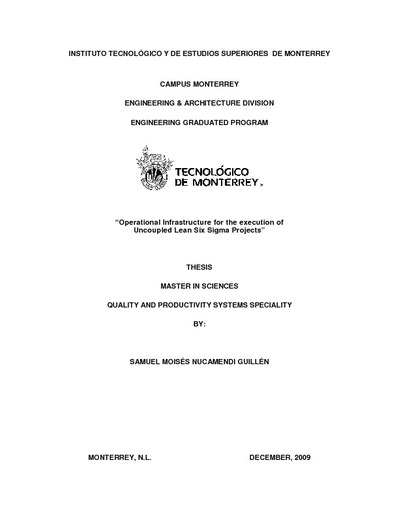Mostrar el registro sencillo del ítem
Operational infrastructure for the execution of uncoupled lean six sigma projects
| dc.contributor.advisor | Hernández Luna, Alberto A. | |
| dc.contributor.author | Nucamendi Guillén, Samuel Moisés | |
| dc.creator | NUCAMENDI GUILLEN, SAMUEL MOISES; 239555 | |
| dc.date.accessioned | 2015-08-17T10:20:43Z | en |
| dc.date.available | 2015-08-17T10:20:43Z | en |
| dc.date.issued | 2009-12-01 | |
| dc.identifier.uri | http://hdl.handle.net/11285/569381 | en |
| dc.description.abstract | Six Sigma is a methodology focused on minimizing variability in a process, resulting in a reduction of defects and under-control operations. However, it is not related with the systemic flow process improvement and its response rates. On the other hand, Lean helps to reduce process complexity focusing in these two last aspects and not in variability and reliability of them. By mixing those complementing approaches in a model called Lean Six Sigma, companies aim to improve both response rates and quality for their products/services. Therefore, with Six Sigma it is possible to get products under specifications, while Lean would be employed to simplify the process, reducing lead time and resources. Tecnológico de Monterrey, using guidelines of Axiomatic and Structured Design, developed an operative Lean Six Sigma model with Value Stream Map as an integrator element. However, the necessary infrastructure to manage such model still needed to be defined. A Lean Six Sigma organization, as every human organization, is a complex system. The viable System Model, developed by Dr. Stafford Beer, is a cybernetic model applied to deal with those administrative Systems. Using this model as reference, general guidelines for: organization structure design; innovation management; self-sufficiency; traceability of changes and management problems detection, were developed. The purpose of this research is to design guidelines and policies for Project Execution using Viable System Model as a tool for diagnosing the management approaches proposed for Lean and Six Sigma methodologies; identifying critical success factors for supporting the Lean Six Sigma infrastructure Model selected and designing a system capable of its administration that serves as a guide in future “In company” deployments. | |
| dc.language | eng | |
| dc.publisher | Instituto Tecnológico y de Estudios Superiores de Monterrey | |
| dc.relation | Investigadores | es_MX |
| dc.relation | Estudiantes | es_MX |
| dc.relation.isFormatOf | versión publicada | es_MX |
| dc.relation.isreferencedby | REPOSITORIO NACIONAL CONACYT | |
| dc.rights | openAccess | |
| dc.rights.uri | http://creativecommons.org/licenses/by-nc-nd/4.0 | * |
| dc.subject.classification | 7 INGENIERÍA Y TECNOLOGÍA | es_MX |
| dc.subject.classification | Area::INGENIERÍA Y TECNOLOGÍA::CIENCIAS TECNOLÓGICAS::TECNOLOGÍA DE LOS ORDENADORES::SISTEMAS AUTOMATIZADOS DE CONTROL DE CALIDAD | es_MX |
| dc.title | Operational infrastructure for the execution of uncoupled lean six sigma projects | |
| dc.type | Tesis de Maestría / master Thesis | |
| dc.contributor.department | Tecnológico de Monterrey, Campus Monterrey | en |
| dc.contributor.committeemember | Moreno Grandas, Diana Paola | |
| dc.contributor.committeemember | González Valenzuela, Eduardo A. | |
| dc.contributor.mentor | Smith Cornejo, Neal Ricardo | |
| refterms.dateFOA | 2018-03-24T14:20:59Z | |
| refterms.dateFOA | 2018-03-24T14:20:59Z | |
| html.description.abstract | Six Sigma is a methodology focused on minimizing variability in a process, resulting in a reduction of defects and under-control operations. However, it is not related with the systemic flow process improvement and its response rates. On the other hand, Lean helps to reduce process complexity focusing in these two last aspects and not in variability and reliability of them. By mixing those complementing approaches in a model called Lean Six Sigma, companies aim to improve both response rates and quality for their products/services. Therefore, with Six Sigma it is possible to get products under specifications, while Lean would be employed to simplify the process, reducing lead time and resources. Tecnológico de Monterrey, using guidelines of Axiomatic and Structured Design, developed an operative Lean Six Sigma model with Value Stream Map as an integrator element. However, the necessary infrastructure to manage such model still needed to be defined. A Lean Six Sigma organization, as every human organization, is a complex system. The viable System Model, developed by Dr. Stafford Beer, is a cybernetic model applied to deal with those administrative Systems. Using this model as reference, general guidelines for: organization structure design; innovation management; self-sufficiency; traceability of changes and management problems detection, were developed. The purpose of this research is to design guidelines and policies for Project Execution using Viable System Model as a tool for diagnosing the management approaches proposed for Lean and Six Sigma methodologies; identifying critical success factors for supporting the Lean Six Sigma infrastructure Model selected and designing a system capable of its administration that serves as a guide in future “In company” deployments. | |
| dc.identificator | 7 | |
| dc.identificator | 33 | |
| dc.identificator | 3304 | |
| dc.identificator | 120306 |
Ficheros en el ítem
Este ítem aparece en la(s) siguiente(s) colección(ones)
-
Ciencias Exactas y Ciencias de la Salud 5426
Ingeniería y Ciencias / Medicina y Ciencias de la Salud


